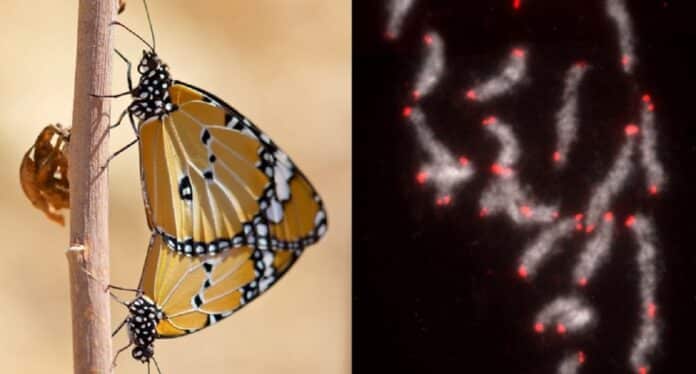Butterflies and moths, two groups of fascinating insects, have recently revealed a remarkable genetic connection. Researchers have discovered that these delicate creatures share ancient “blocks” of DNA, providing insights into their shared evolutionary history.
By unraveling the mysteries hidden within their genetic code, scientists hope to understand better the diverse and vibrant world of butterflies and moths. This discovery sheds light on life’s intricate tapestry and highlights nature’s enduring marvels.
New research has unveiled a fascinating genetic discovery about butterflies and moths. Scientists from the Universities of Exeter, Lübeck, and Iwate have developed a tool to compare the chromosomes of various butterfly and moth species. Their findings reveal the existence of “blocks” of chromosomes shared among all moth and butterfly species and Trichoptera, which are aquatic caddisflies that shared a common ancestor with moths and butterflies approximately 230 million years ago.
Despite the wide variation in the number of chromosomes among moths and butterflies, ranging from 30 to 300, the study provides compelling evidence of shared homology blocks, suggesting a genetic connection dating back over 200 million years.
Professor Richard French-Constant, from the Centre for Ecology and Conservation on Exeter’s Penryn Campus in Cornwall, said, “DNA is compacted into individual particles or chromosomes that form the basic units of inheritance. “If genes are on the same ‘string,’ or chromosome, they tend to be inherited together and are therefore ‘linked.”
Addressing the challenge posed by the varying numbers of chromosomes in different animals and plants, scientists have developed a straightforward technique to identify the relatedness of chromosomes. The method analyzes blocks of genes on each chromosome to gain insights into their evolution across different species.
In the case of Lepidoptera, the researchers discovered 30 fundamental units of synteny, indicating genetic similarities in all butterflies and moths. Astonishingly, these units can be traced back to their sister group, the caddisflies or Trichoptera, providing valuable information about their shared genetic heritage.
Butterflies, known for their significance in conservation efforts, are now proving valuable models for studying chromosome evolution, as revealed by this study. While human activity has led to the decline of many butterfly species globally, this research enhances our understanding of the genetic evolution in moths and butterflies.
Furthermore, the techniques employed in this study hold promise for investigating chromosome evolution in other animal and plant groups, offering insights into their evolutionary processes.
Journal Reference:
- Walther Traut, Ken Sahara, et al., Lepidopteran Synteny Units reveal deep chromosomal conservation in butterflies and moths.G3 Genes/Genomes/Genetics. DOI: 10.1093/g3journal/jkad134.
